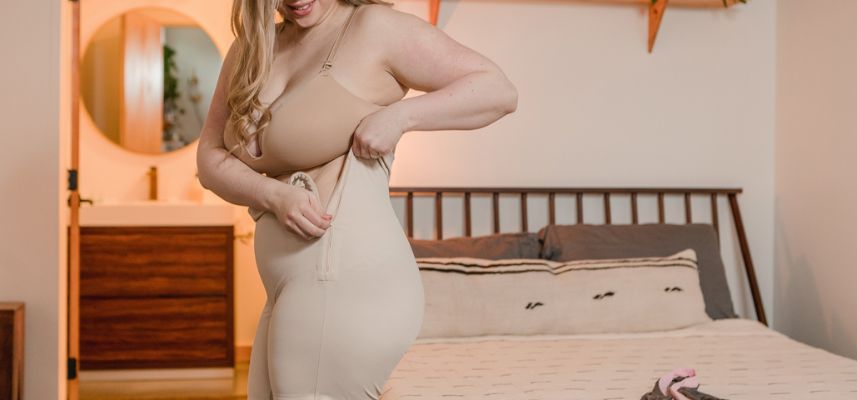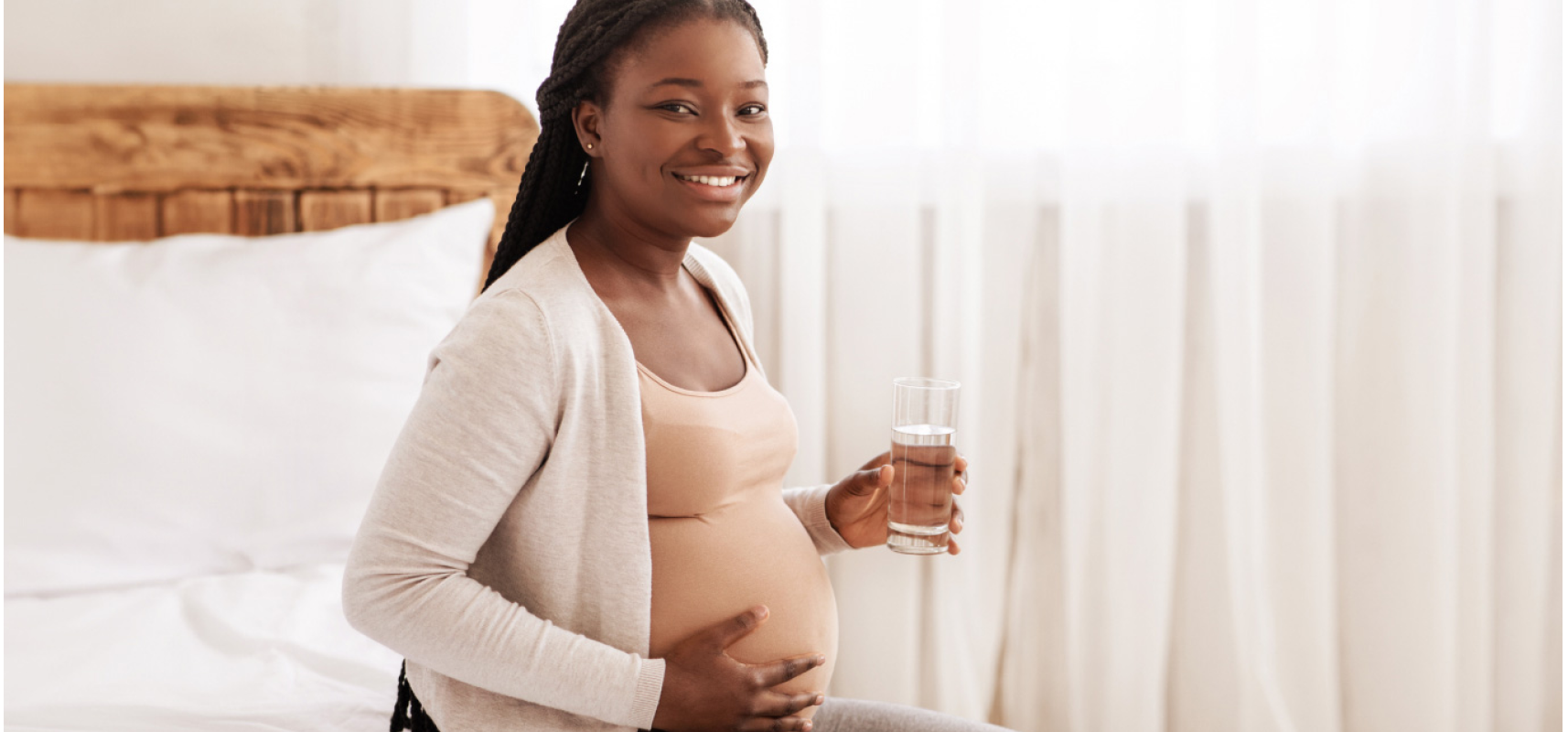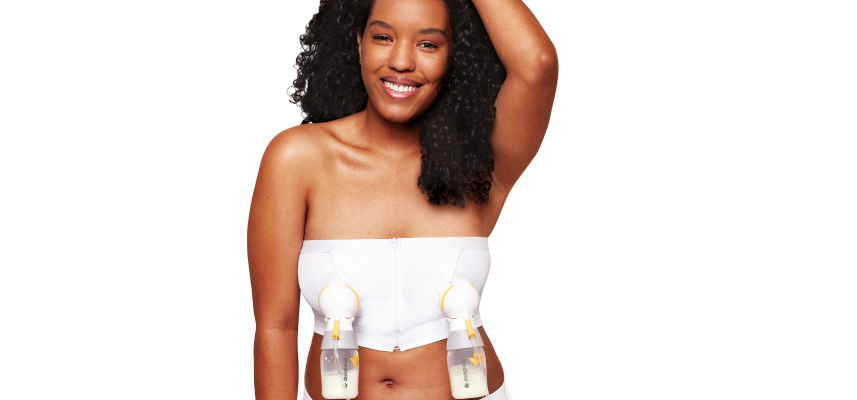Postpartum compression garments are FDA-listed medical devices specifically designed to support your recovery after childbirth. These garments provide gentle compression to help reduce swelling, support weakened abdominal muscles, improve circulation, and accelerate healing for both vaginal delivery and C-section recovery. It’s important for new moms to know that unlike shapewear, medical-grade compression garments focus on health benefits rather than appearance!
The postpartum period brings significant physical changes for your body as it recovers from pregnancy and childbirth. You might have worn maternity compression garments while pregnant, and wearing postpartum compression garments can provide similar benefits. Postpartum recovery garments can help support your comfort during this critical healing phase. In this guide, we'll explore the benefits, types, and proper use of these medical-grade devices, sharing information about how they can impact your postpartum recovery.
IN THIS ARTICLE:
Do Compression Garments Help Postpartum?
What is the Difference Between Stage 1 and Stage 2 Compression Garments?
What is the 5-5-5 Rule Postpartum?
What is the Best Thing to Wear Postpartum?
What to Wear for Postpartum Abdominal Support?
Benefits of Medical-Grade vs. Regular Shapewear
When to Start Wearing Postpartum Compression
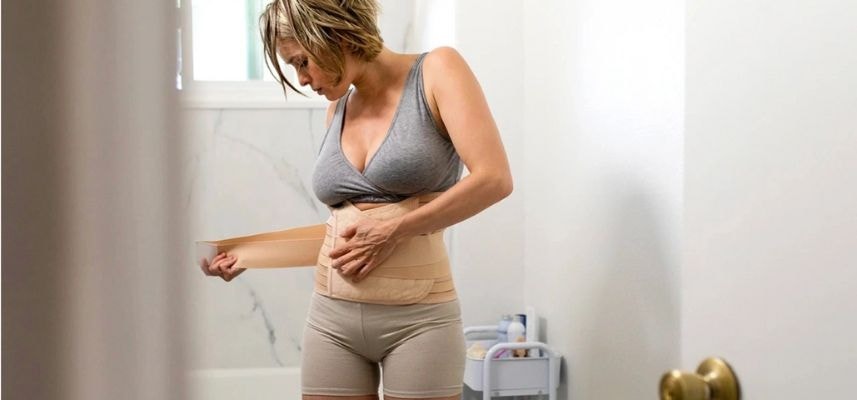

Do Compression Garments Help Postpartum?
Yes, postpartum compression garments provide substantial benefits for recovery after both vaginal birth and cesarean delivery! These specifically designed medical devices offer:
Physical Recovery Benefits
-
Reduced swelling and fluid retention: Gentle compression helps move excess fluid back into the lymphatic system
-
Abdominal and back muscle support: Provides stability to weak muscles that were stretched or strained during pregnancy
-
Improved circulation: Enhances blood flow to promote faster healing
-
Pain reduction: Alleviates discomfort from pregnancy-related changes and surgical incisions
-
Enhanced posture: Supports proper alignment as the body readjusts post-delivery
Functional Improvements
-
Increased mobility: Support garments help you move more comfortably during daily activities
-
Improved abdominal strength and stability: Assists weakened core muscles in regaining strength
-
Reduced back pain: Provides extra support to your lower back and pelvis
-
Faster return to activities: May help accelerate the timeline for resuming normal function
According to Caitlyn Tivy, PT, DPT, OCS, Medical Advisor of Aeroflow Breastpumps, "Medical-grade compression garments are designed to work with the body's natural healing processes. The gentle, targeted compression helps support tissues as they recover while promoting healthy circulation."
What is the Difference Between Stage 1 and Stage 2 Compression Garments?
Postpartum compression garments are categorized into different stages based on the level of compression and when you plan to use them..
Stage 1 Compression (Immediate Postpartum - 6 weeks)
Compression Level: Light to moderate (around 15-20 mmHg)
Best for: Immediate post-delivery recovery
Features:
-
Lightweight and breathable fabric for sensitive post-birth skin
-
Gentle support for swollen tissues
-
Easy wear design for hospital and early home use
-
Split crotch design for convenient bathroom trips
-
Adjustable fit to accommodate changing body size
Ideal timing: Can be worn starting a few days after vaginal delivery or once cleared by your healthcare provider after a C-section
Stage 2 Compression (6+ weeks postpartum)
Compression Level: Moderate to firm (around 20-30 mmHg)
Best for: Continued recovery and adaptation to a changing body
Features:
-
Firmer compression for ongoing muscle support
-
More structured design for daily activities
-
Enhanced core support
-
Longer-term wear comfort
-
Advanced garment features for active lifestyles
Caitlyn explains, "For postpartum people, stage 1 garments focus primarily on healing and comfort, while stage 2 garments provide more substantial support as muscles begin to strengthen and women return to more active routines."
The transition between stages should be guided by your individual recovery progress and healthcare provider recommendations.
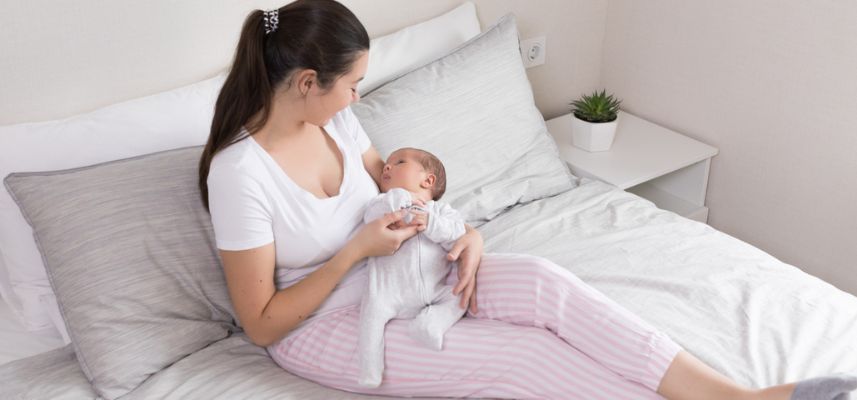

What is the 5-5-5 Rule Postpartum?
You might have heard about the "5-5-5 rule" from your favorite influencer or pregnancy website. Here's what it means:
-
5 days in bed
-
5 days on the bed
-
5 days near the bed
Here's what science and medicine actually say about it:
Rather than thinking about the "5-5-5 rule" as complete bedrest for multiple days postpartum, think of it as a recommendation to take it easy during your recovery period. This means limiting and easing into physical activities, listening to your body and resting when necessary. The "in bed" and "on the bed" phases are relative, not literal. Lying in bed for 24 hours and doing nothing else is neither realistic nor helpful in most cases.
Instead, most healthcare providers recommend balancing rest with gentle movement from the start. Light activities like short walks, pelvic tilts, and gentle stretches are important for healing. Movement helps promote circulation, prevents blood clots, and supports recovery, particularly after surgical interventions like C-sections.
How compression garments support your actual recovery:
Rather than following internet rules, work with your healthcare provider to develop a recovery plan tailored to your delivery type and individual needs. Postpartum compression garments can provide support as you balance rest with necessary activity and gradually increase your movement over time.


What is the Best Thing to Wear Postpartum?
This varies from person to person! The best postpartum garments depend on your individual needs, delivery type, and recovery goals. That said, consider the following when looking for the right postpartum recovery garments.
Types of Postpartum Compression Products
Postpartum Girdle with Abdominal Support
Purpose: Also known as a postpartum belly wrap, band, or binder, these garments protect incision sites while providing helpful compression
Best for: Cesarean birth recovery and supporting weakened core muscles
Recommended features:
-
Soft fabric that won't irritate incision sites
-
Adjustable compression levels
-
Easy-access design for medical checks
-
Breathable materials to prevent overheating
-
Side zipper or front closure for easy wear
-
Anti-bacterial properties to support healing
Abdominal Compression Wraps
Purpose: Provide targeted support to your core and lower back
Best for: Women with diastasis recti or significant abdominal weakness
Recommended features:
-
Adjustable compression levels (through the ability to tighten or loosen the garment)
-
Velcro or hook-and-eye closures
-
Breathable, medical-grade fabric
-
Machine washable design
Full-torso Compression Garments
Purpose: Support your entire torso while addressing common postpartum concerns
Best for: Overall recovery support and enhanced confidence
Recommended features:
-
Gentle, targeted compression from bust to hips
-
Adjustable shoulder straps for comfort
-
Built-in bra support for breastfeeding convenience
-
Seamless design for comfort under clothing
-
Silicone thigh grippers for good support to prevent fabric from rolling
-
Snap-crotch for convenience
Compression Leggings and Shorts
Purpose: Support lower body circulation and muscle stability
Best for: Active recovery and daily wear and moms looking to increase physical activity
Recommended features:
-
Graduated compression to support natural blood flow
-
Moisture-wicking fabric
-
Four-way stretch for ease of movement
-
Reinforced seams for durability
High-quality Compression Socks
Purpose: Compression socks help reduce leg swelling and prevent varicose veins
Best for: All moms, especially C-section moms with limited mobility! This is because reduced movement post-surgery limits your muscles' ability to pump and assist with circulation. Compression socks can provide that extra boost until you're feeling up to walking and moving more.
Recommended features:
-
Tight fit that provides compression while still being easy to put on and take off
-
If you notice a pronounced “ring” or “shelf” of swelling at the top of the sock when you remove it, it’s too tight and you need a larger size!
-
-
Breathable, comfortable fabric
-
Machine washable
Caitlyn notes, "The best postpartum garments are whichever ones that you'll wear consistently to address your individual recovery needs. Some moms benefit most from abdominal support, while others need full-body compression or targeted leg support."
What to Wear for Postpartum Abdominal Support?
Your body will be different after giving birth—and that's okay! While postpartum recovery garments may temporarily change the appearance of your body when worn, it's important to understand their intended use is to provide comfort while you heal. These garments can help you feel supported by stabilizing joints, relieving pain and discomfort, and providing back support.
Postpartum compression garments can provide:
-
Temporary smoothing effect and support for postural muscles while worn
-
Support for diastasis recti (abdominal muscle separation)
-
Confidence boost during the adjustment period
However, they do not:
-
Permanently flatten the stomach without lifestyle changes
-
Replace the need for appropriate nutrition and exercise
-
Instantly return the body to a pre-pregnancy state
Healthy Approach to Postpartum Recovery
New moms face a lot of pressure from the media, society, and even loved ones. Focus on your recovery by remembering the following points:
Medical-grade garments put health first: Support healing, reduce pain, and improve function rather than solely appearance
Gradual progression: Combine compression wear with healthcare provider-approved exercises as recovery progresses
Realistic timeline: Understand that significant physical changes require months or years depending on your healing journey
Our experts emphasize that healthy recovery takes time. Compression garments should support your wellness goals rather than contributing to unrealistic appearance expectations.
Benefits of Medical-Grade vs. Regular Shapewear
Medical-Grade Compression Garments
Designed by healthcare professionals for therapeutic benefits, these garments offer real health benefits backed by research. They provide support and deliver gentle compression for a variety of needs. Look for the following features:
-
FDA-listed medical device status
-
Graduated compression for optimal circulation
-
Breathable, hypoallergenic materials
-
Support for specific postpartum conditions
Regular Shapewear
Designed for appearance enhancement, shapewear should not replace postpartum compression products. Here's how to spot shapewear:
-
Focus on smoothing or appearance rather than healing
-
May restrict circulation with excessive compression
-
Often uncomfortable for extended wear
-
No medical oversight in design
-
Limited health benefits
The distinction matters significantly for postpartum recovery, where medical considerations outweigh cosmetic concerns.
When to Start Wearing Postpartum Compression
Follow these tips for both C-section and vaginal births:
-
Healthcare provider clearance - Always confirm timing with your medical team.
-
Within the first few days after delivery - Stage 1 compression can typically begin once initial swelling subsides. Consider moving on to stage 2 compression after about 6 weeks.
-
Listen to your body's signals - Start gradually and adjust based on comfort. Be mindful of the C-section incision site. As you progress through recovery, you may transition from Stage 1 to Stage 2 compression, or gradually reduce your reliance on compression garments altogether as your body heals and strengthens. Some women benefit from longer use, others graduate and stop using compression garments sooner.
Proper Fit and Safety Guidelines
Keep these tips in mind to achieve a snug and secure fit that's comfortable:
Snug but not restrictive - Compression should feel supportive without being uncomfortably tight
No deep indentations - Properly fitted garments shouldn't leave permanent marks on your skin
Comfort during movement - Should allow normal breathing and basic activities
Gradual adjustment - Your body will change during recovery, requiring size adjustments. If the garment doesn’t offer built-in adjustments, you’ll “grow out of it” quickly
Safety Considerations
Avoid excessive compression - Too-tight garments can impair circulation and healing
Monitor skin and wound/incision site health For C-sections and perineal tears - Remove garments if irritation or unusual redness occurs
Balance wear time - Allow skin to breathe between wearing periods
Medical supervision - Consult with your healthcare provider if you have any concerns before using compression and if you have any concerns during use
Warning Signs to Watch For
-
Increased pain or discomfort while wearing
-
Skin irritation or rash development
-
Numbness or tingling in compressed areas
-
Difficulty breathing or excessive restriction
-
Worsening swelling despite compression use


Getting Compression Garments Through Insurance
Many postpartum compression garments qualify as durable medical equipment (DME) and may be covered by insurance when prescribed by healthcare providers.
Insurance Coverage Requirements
Medical necessity: Healthcare provider must document the need for compression therapy
Prescription requirement: Most insurance plans require a written prescription
Approved suppliers: Coverage is often limited to approved DME providers
Documentation: Your may need to provide medical records supporting therapeutic need
Working with Aeroflow Breastpumps
Aeroflow Breastpumps specializes in helping moms access covered postpartum compression garments, breast pumps, classes, and more. Here's how you can get postpartum compression garments through insurance:
-
Step 1: Provide your insurance information (you'll need your insurance card!)
-
Step 2: Choose from the curated list of postpartum recovery items, breast pumps, and classes covered by your insurance
-
Step 3: We'll verify your prescription and deliver your supplies right to your door!
Caitlyn says, "Many moms don't realize their postpartum compression garments may be covered benefits. We help navigate the process to ensure mothers get the medical-grade support they need!"
Combining Compression with Overall Recovery
Postpartum compression garments work best as part of a comprehensive recovery approach. Consider incorporating these complementary recovery strategies to your routine:
Appropriate nutrition: Support healing with balanced meals and adequate hydration
Light and low-impact exercises: This can include pilates or other mat work, slow walks, gentle yoga or stretching, and pelvic floor exercises. Follow healthcare provider guidelines for safe activity progression
Adequate rest: Prioritize sleep and stress management for optimal healing
Professional support: Work with physical therapists, lactation consultants, and other specialists to help you throughout your journey
For Gradual Independence
Strengthening exercises: Use compression support while rebuilding core strength and incorporating more moderate forms exercise. This will vary from one person to another, so make adjustments that make sense for your body and recovery journey
Activity progression: Gradually increase activities as healing allows
Weaning timeline: Compression garments can be worn for up to four months postpartum. Slowly reduce compression garment dependency to promote long-term wellness. For example, if you've been wearing a belly band 16 hours a day, reduce the time to 12-14 hours, taking a couple of short breaks without the band. If you do this for a couple of days and you're feeling good, reduce it to 10-12 hours. Repeat this process until you feel comfortable and supported without the band!
The Support You Need
Postpartum compression garments serve as valuable medical tools to support your recovery after childbirth. When used appropriately, these FDA-listed devices provide targeted benefits including reduced swelling, muscle support, improved circulation, and enhanced comfort during the healing process. The key lies in choosing appropriate medical-grade garments, ensuring proper fit, and using them as part of a comprehensive recovery plan guided by your healthcare provider.
Remember, everyone's postpartum recovery journey is unique. Work with your healthcare provider to determine the most appropriate compression support for your individual needs and circumstances. For personalized guidance on postpartum compression garments and insurance coverage, connect with our team of certified specialists who can help you navigate options and access medical-grade recovery support.

